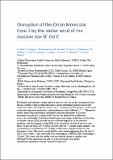Por favor, use este identificador para citar o enlazar a este item:
http://hdl.handle.net/10261/207570COMPARTIR / EXPORTAR:
 SHARE SHARE
 CORE
BASE CORE
BASE
|
|
| Visualizar otros formatos: MARC | Dublin Core | RDF | ORE | MODS | METS | DIDL | DATACITE | |

| Título: | Disruption of the Orion molecular core 1 by wind from the massive star θ1 Orionis C |
Autor: | Pabst, C.H.M. CSIC; Higgins, R.; Goicoechea, Javier R. CSIC ORCID; Teyssier, D.; Berné, O.; Chambers, E.; Wolfire, M.; Suri, S.T.; Guesten, R.; Stutzki, J.; Graf, U.U.; Risacher, C.; Tielens, A.G.G.M. | Fecha de publicación: | 7-ene-2019 | Editor: | Springer Nature | Citación: | Nature 565: 618-621 (2019) | Resumen: | Massive stars inject mechanical and radiative energy into the surrounding environment, which stirs it up, heats the gas, produces cloud and intercloud phases in the interstellar medium, and disrupts molecular clouds (the birth sites of new stars). Stellar winds, supernova explosions and ionization by ultraviolet photons control the lifetimes of molecular clouds. Theoretical studies predict that momentum injection by radiation should dominate that by stellar winds, but this has been difficult to assess observationally. Velocity-resolved large-scale images in the fine-structure line of ionized carbon ([C ii]) provide an observational diagnostic for the radiative energy input and the dynamics of the interstellar medium around massive stars. Here we report observations of a one-square-degree region (about 7 parsecs in diameter) of Orion molecular core 1—the region nearest to Earth that exhibits massive-star formation—at a resolution of 16 arcseconds (0.03 parsecs) in the [C ii] line at 1.9 terahertz (158 micrometres). The results reveal that the stellar wind originating from the massive star θ Orionis C has swept up the surrounding material to create a ‘bubble’ roughly four parsecs in diameter with a 2,600-solar-mass shell, which is expanding at 13 kilometres per second. This finding demonstrates that the mechanical energy from the stellar wind is converted very efficiently into kinetic energy of the shell and causes more disruption of the Orion molecular core 1 than do photo-ionization and evaporation or future supernova explosions. | Descripción: | 16 pags., 9 figs., 1 tab. | Versión del editor: | http://dx.doi.org/10.1038/s41586-018-0844-1 | URI: | http://hdl.handle.net/10261/207570 | DOI: | 10.1038/s41586-018-0844-1 | Identificadores: | doi: 10.1038/s41586-018-0844-1 issn: 1476-4687 |
| Aparece en las colecciones: | (CFMAC-IFF) Artículos |
Ficheros en este ítem:
| Fichero | Descripción | Tamaño | Formato | |
|---|---|---|---|---|
| Disruption of the Orion.pdf | 2,48 MB | Adobe PDF |  Visualizar/Abrir |
CORE Recommender
PubMed Central
Citations
3
checked on 25-abr-2024
SCOPUSTM
Citations
84
checked on 23-abr-2024
WEB OF SCIENCETM
Citations
76
checked on 28-feb-2024
Page view(s)
132
checked on 23-abr-2024
Download(s)
119
checked on 23-abr-2024
Google ScholarTM
Check
Altmetric
Altmetric
Artículos relacionados:
NOTA: Los ítems de Digital.CSIC están protegidos por copyright, con todos los derechos reservados, a menos que se indique lo contrario.
